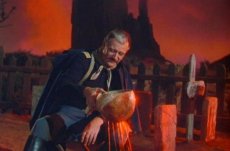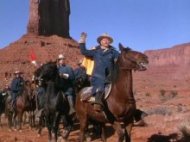Movie she Wore a Yellow Ribbon

She Wore a Yellow Ribbon (1949)
Directed by John Ford
Argosy Pictures / RKO Radio Pictures
As a cinephile, I feel like any criticism of the almighty John Ford must be made in hushed tones.
So in that spirit, let me begin by praising the aspects of She Wore a Yellow Ribbon that I found praiseworthy.
She Wore a Yellow Ribbon is one of the most beautifully shot westerns I’ve ever seen. Winton C. Hoch won the Academy Award for best color cinematography for this film, and he deserved it. Hoch had previously shot (1948) for Ford, and would go on to lens three more films for Ford, The Quiet Man (1952), Mister Roberts (1955), and The Searchers (1956).
Technicolor is a process that often looked oversaturated and occasionally even gaudy, but She Wore a Yellow Ribbon looks simultaneously lifelike and hyperreal. It stands as a towering achievement of what a talented cinematographer could do when shooting in Technicolor.
I also really enjoyed Ben Johnson’s performance as Sgt. Tyree, a former Confederate captain now serving in the U.S. Cavalry as a scout. Johnson was as comfortable in the saddle as he was on his own two legs, and he would go on to a long career in Hollywood, specifically in westerns. I enjoyed his role in Mighty Joe Young (1949), but it didn’t hint at his future greatness in the same way that his performance in She Wore a Yellow Ribbon does. I also enjoyed Richard Hageman’s score, and I found this film enjoyable moment to moment.
Nevertheless, we want to offer you visit site.
But overall, I really didn’t like it. I like plenty of John Ford’s movies just fine, but for more than 20 years I have been mystified by the universal reverence film fans have for his work.
 She Wore a Yellow Ribbon is emblematic of what I don’t like about Ford’s films. His westerns were grand operations in mythmaking, but with an excess of sentimentality. They were historically inaccurate and geographically incoherent, and without a great actor like Henry Fonda in the lead, his films feel like they’re adrift at sea.
She Wore a Yellow Ribbon is emblematic of what I don’t like about Ford’s films. His westerns were grand operations in mythmaking, but with an excess of sentimentality. They were historically inaccurate and geographically incoherent, and without a great actor like Henry Fonda in the lead, his films feel like they’re adrift at sea.
I like John Wayne. I really do. But he was better at being an iconic presence than he was at turning in a good performance. The only “performances” of his I’ve found compelling were ones that contained a streak of nastiness, like his roles in Red River (1948) and The Searchers (1956). In She Wore a Yellow Ribbon, Wayne is mostly himself, but he has a few opportunities to emote, and those scenes were dead on arrival for me. There’s nothing interesting about his character, unlike Henry Fonda’s deeply flawed character in Fort Apache (1948).
This is a film with remarkably low dramatic stakes. Almost nothing happens in She Wore a Yellow Ribbon. This would be fine if it were simply a realistic look at the role the U.S. Cavalry played in the settling of the American West, but it’s not in any way realistic or historically accurate. It takes place in 1876, shortly after the massacre of General Custer and the 7th Cavalry at the Battle of the Little Bighorn. The film’s narrator informs us that multiple Indian nations are joining forces to fight the U.S. government en masse, and that just one more defeat like the one Custer suffered and it will be a century before the Pony Express will be able to safely cross the west again. Historically, this is utter hogwash, and not just because the Pony Express ceased operations in 1861.
You might also like







